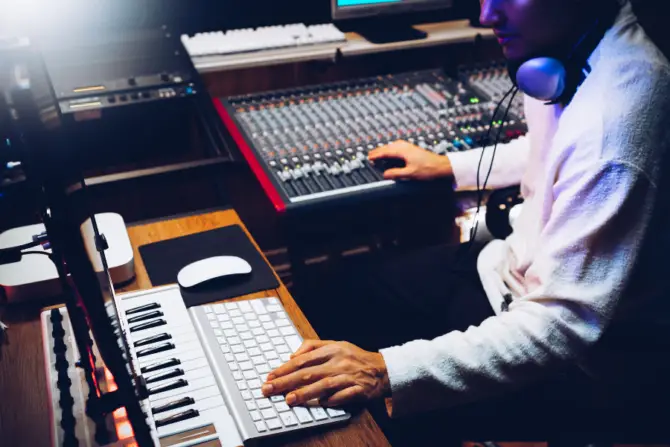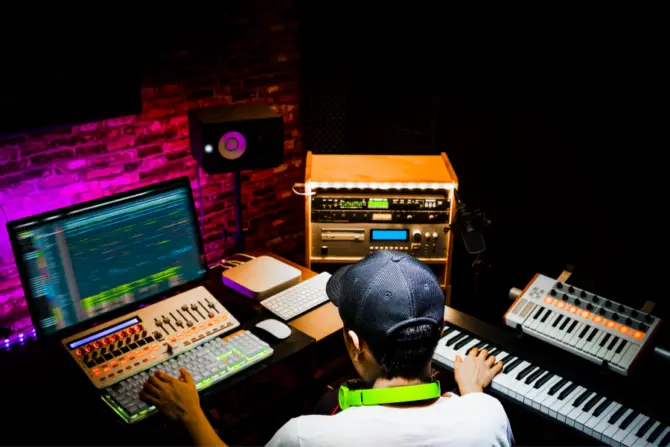In the world of music production, synthesizers and digital audio workstations (DAWs) have become integral components. While both tools offer unique abilities in creating and shaping sound, they are often used together to achieve the desired music outcomes. Understanding the differences between synthesizers and DAWs can help one make an informed decision about which tool to use in different scenarios.
Table of Contents
- Synthesizer vs DAW – Understanding Synthesizers
- Synthesizer vs DAW – Decoding DAW
- Comparison: Synthesizer vs DAW
- Hardware and Software
- Video – Synthesizer vs DAW, and How to Record a Synthesizer into a DAW
- Popular Synths and DAW Brands
- Integration with Music Production
- Practicality and User Experience
- Frequently Asked Questions
- What are the main differences between hardware and software synths?
- How does sound quality compare between synthesizers and DAWs?
- What are the advantages of using a synthesizer in music production?
- Why might someone choose a DAW over a hardware synthesizer?
- Are there any major differences in workflow between synthesizers and DAWs?
- Which is better for beginners: a synthesizer or a DAW?

Synthesizers are electronic musical instruments that generate audio signals, which can be modified and combined to create a wide variety of sounds. They come in various forms, including hardware and software versions. Many music producers prefer using synthesizers due to their hands-on control and quick sound design capabilities.
On the other hand, Digital Audio Workstations (DAWs) are comprehensive software applications designed for recording, editing, and producing audio tracks. DAWs provide a versatile platform for managing various components of a music project, including MIDI instruments, effects processing, and audio routing. These powerful tools streamline the creative process for producers and enable them to construct complex compositions with relative ease.
Key Takeaways
- Synthesizers are electronic instruments that generate and manipulate sound, while DAWs are software applications for recording, editing, and producing audio.
- Both synthesizers and DAWs come in hardware and software versions, often used together to achieve desired musical outcomes.
- Understanding the differences between synthesizers and DAWs can aid in making informed decisions for music production needs.
Synthesizer vs DAW – Understanding Synthesizers
Synthesizers are electronic musical instruments that generate sounds through manipulating electrical signals. These signals are then converted to audible sound waves, which can be used in various music genres such as EDM, pop, and hip-hop. There are two primary types of synthesizers: analog and digital.
Analog Synthesizers
Analog synthesizers utilize analog electronics to produce and manipulate electrical signals. These synths are known for their warm, rich sound and hands-on controls. Some popular brands that manufacture analog synthesizers include Moog, Sequential, Arturia, and Korg. Yamaha is also a well-known brand for digital pianos, which occasionally incorporate analog synthesizer features.
Analog synthesizers usually have a variety of knobs and controls, allowing the user to manually manipulate parameters such as oscillator frequency, filter cutoff, and envelopes. Oscillators generate the base waveform in an analog synth, with various knobs adjusting the pitch and other qualities. Analog synthesizers typically offer a more hands-on experience due to the tactile nature of their control surfaces.
Digital Synthesizers
Digital synthesizers work by processing digital signals to generate sounds. These synths are often more versatile than their analog counterparts, as they can replicate virtually any sound, including those produced by analog synths. Renowned manufacturers of digital synthesizers include Roland and Korg.
Unlike analog synthesizers, digital synths often feature digital displays or screens, allowing users to access and modify parameters through menu-driven systems. While digital synthesizers might not have as many tactile controls such as knobs, they usually offer a wide range of sound options and effects.
In conclusion, whether one prefers analog or digital synthesizers often comes down to personal preference and intended use. Each has its strengths and limitations, but both can produce captivating and engaging sounds for music production and live performance.
Synthesizer vs DAW – Decoding DAW
In today’s world of technology, it’s essential for aspiring musicians to understand the role of a Digital Audio Workstation (DAW) in music production. A DAW is a fundamental piece of software that allows for recording, editing, and creating audio files. It serves as the backbone of any music production process and is favored by both professionals and hobbyists alike.
DAW as Recording
A DAW provides a flexible recording environment for musicians, allowing them to capture various types of sound sources. With its ability to interface with a variety of instruments, such as MIDI keyboards and USB controllers, a DAW simplifies the process of recording multiple tracks and implementing different effects. By seamlessly integrating with various hardware components, users can streamline their creative process.
A popular aspect of DAWs is their MIDI sequencer functionality. MIDI, or the Musical Instrument Digital Interface, is a protocol that allows electronic instruments and computers to communicate and control each other. Sequencers in a DAW enable the manipulation of MIDI data to create musical patterns and compositions. This functionality allows for intricate arrangements and sound designs, contributing to the overall richness and depth of a production.
Some of the most widely known DAWs include Ableton, FL Studio, and Reaper. Each of these programs offers unique features and capabilities to cater to different production styles and workflows. For example, Ableton is preferred by live performers due to its intuitive interface and customization options, whereas FL Studio is often chosen for its pattern-based approach and extensive plugin library. Users may also appreciate Reaper’s affordability and efficient resource management.
In conclusion, a DAW is a crucial element in modern music production, providing unparalleled functionality and versatility to artists of all genres. By decoding its capabilities, one can unlock the full potential of their creative expression.

Comparison: Synthesizer vs DAW
Cost Perspective
When it comes to cost, synthesizers and digital audio workstations (DAWs) can vary significantly. A hardware synthesizer’s price can range from budget-friendly models like the Yamaha PSR-E363 to high-end, professional models such as the Yamaha CP300. DAWs, on the other hand, can be more affordable as they are software-based and don’t require physical components. Some DAWs even offer free or low-cost versions with limited features, making them an attractive option for beginners or those on a budget.
Technology and Workflow
Synthesizers:
- Hardware synthesizers are standalone electronic instruments that generate audio signals which can be converted into sound. They come in various forms, such as keyboard-based models like the Yamaha EZ-220 or smaller, more portable options like the Casio SA-76 and Casio SA-46.
- Synthesizers can produce a wide range of sounds and are often favored by musicians who prefer a hands-on approach to creating music. However, they can be limited in terms of editing and arranging capabilities compared to a DAW.
DAWs:
- Digital audio workstations are software applications used for recording, editing, and producing audio files. Some popular DAWs include Ableton Live, FL Studio, and Logic Pro.
- DAWs offer a more versatile and efficient workflow, allowing users to manipulate and arrange multiple audio tracks, apply effects, automate parameters, and more. This flexibility makes DAWs an essential tool for modern music production.
In summary, synthesizers and DAWs have their own unique advantages and limitations. The choice between them depends on factors such as cost, preference for hands-on control, and the desired level of editing and arranging capabilities. Both tools can be utilized in tandem to create a comprehensive and personalized music production setup.
Hardware and Software
Synths: Hardware vs Software
Hardware synthesizers are made of physical components that generate sound. They have been the traditional choice for electronic music production, and some musicians prefer their hands-on approach and unique sound characteristics. On the other hand, software synthesizers are computer programs that emulate the sound and functionality of a synthesizer. They offer more flexibility in terms of choice, as the only limit is your computer’s processing power, so they can provide a wide range of sound options.
Both hardware and software synths have their pros and cons. Some advantages of hardware synths include their tactile nature, ease of use for live performances, and potential for better resale value. Meanwhile, software synths excel in terms of sound variety, easier editing capabilities, and overall affordability. It fundamentally depends on the user’s preference and requirements in choosing the right instrument for their needs.
DAW Hardware and Plugins
Digital Audio Workstations (DAWs) are software platforms that provide a comprehensive environment for creating, editing, and producing music. DAWs integrate with both hardware and software instruments, including synthesizers, effects, and plugins. Users can expand their sonic possibilities by incorporating plugins, which are virtual instruments or effects that can be utilized within the DAW software. These can range from synthesizers to mixing tools or audio processing effects.
Some popular DAWs like FL Studio, Ableton Live, and Studio One offer both built-in virtual instruments and support for external plugins. By integrating with hardware synthesizers and other external devices, they offer a versatile and powerful platform for music production.
While using DAWs, it’s essential to consider both hardware and software components. Hardware components include the computer, audio interface, and MIDI controllers, all of which are crucial for a smooth workflow. In addition to virtual instruments, users can enrich their soundscapes by incorporating audio plugins that cater to various audio effects, including modulation, compression, and equalization.
When it comes to choosing between hardware and software synthesizers, DAW hardware, and plugins, the decision ultimately depends on personal preference, budget, and workflow style. With the right combination of these elements, musicians can create powerful and expressive soundscapes tailored to their own unique style and goals.
Video – Synthesizer vs DAW, and How to Record a Synthesizer into a DAW
In this video below, Noize London shows step by step in how to record your synthesizer into a DAW.
Popular Synths and DAW Brands
Renowned Synthesizer Makers
In the world of synthesizers, there are several renowned brands known for their quality and innovation. Among these popular synth makers, we find Yamaha, widely recognized for their keyboards such as the DGX 660, P45, and YPT 255, offering musicians a variety of options for different skill levels and budgets (Yamaha DGX 660 Tutorial, Yamaha P45 Review, Yamaha YPT 255 Review). Another iconic synthesizer manufacturer is Roland, known for their high-quality instruments like the Roland JUNO DS88. Moog is another major synth maker, popular for their iconic Minimoog and subsequent innovative synthesizer models.
Other prominent synthesizer creators include Korg, well-known for their versatile and affordable Volca series, and Arturia, famous for their MicroFreak and other synthesizers. Waldorf, Modal, Behringer, and Sequential are additional reputable brands, each offering their unique sound and feature set, attracting fans worldwide.
Software Giants
In the realm of Digital Audio Workstations (DAWs) and software synthesizers, several prominent companies stand out. Ableton is a major player, with their popular DAW, Ableton Live, preferred by many electronic music producers. Native Instruments is another influential company in the industry, offering an extensive range of audio software like Reaktor and the highly acclaimed synthesis plugin, Omnisphere.
Apart from these giants, various other developers contribute to the ever-growing pool of software synth plugins and DAWs. Among them are Apple, with their widely-used DAW, Logic Pro, and GarageBand for beginners, as well as Cakewalk, Cockos Reaper, and Image-Line FL Studio. Many smaller companies and individuals also contribute to the rich ecosystem of synthesizers and DAWs, making it an exciting time for music producers and sound designers.
Integration with Music Production
When it comes to integrating synthesizers and digital audio workstations (DAWs) into music production, each tool has its unique advantages depending on the genre and approach. In this section, we will explore how both synths and DAWs contribute to electronic music and hip-hop production.
In Electronic Music
Electronic music relies heavily on the use of synthesizers and DAWs to create its distinct, electronic soundscapes. Synths often provide the core foundation for electronic music, utilizing their ability to generate a wide range of sounds, from melodic leads to complex pads. Producers frequently use MIDI keyboards to control their synthesizers, allowing them to play and record notes with ease.
DAWs, such as Ableton Live, play an essential role in electronic music production by providing a platform to arrange, manipulate, and produce the sounds generated by synthesizers. DAWs offer various built-in virtual instruments, effects, and processors, enabling electronic music producers to create and shape their sounds further. MIDI data can be recorded and edited within the DAW, giving complete control over timing, pitch, and expression.
In Hip-Hop
In hip-hop production, synthesizers are often used to create melodic hooks, basslines, and harmonic textures. They can add depth and character to a track by providing unique, expressive sounds that differentiate it from other tracks. MIDI keyboards are also a popular choice for hip-hop producers when working with synths, allowing for real-time playability, and intuitive control over the synthesizer’s parameters.
DAWs play a crucial role in hip-hop production by offering a platform for recording, editing, and arranging audio clips and MIDI data. Most modern hip-hop tracks are produced using music production software like FL Studio, Logic Pro, or Ableton Live. These DAWs provide essential tools such as sampling, looping, and automation, helping to define the genre’s sound.
Overall, both synths and DAWs play pivotal roles in music production across various genres. In electronic music and hip-hop, they complement each other by providing a powerful combination of sound generation, manipulation, and arrangement capabilities.
Practicality and User Experience
Ease of Use
When comparing synthesizers and DAWs, it’s essential to consider the ease-of-use factor. Synthesizers, especially hardware ones, come with knobs, sliders, and buttons that provide a hands-on experience for shaping sound. This physical interaction allows users to quickly adjust parameters and achieve their desired sound. However, the learning curve for synths can be steep especially for beginners, as each synthesizer model has its unique layout, terminology, and functions.
On the other hand, DAWs offer a more streamlined approach to creating music. They present a visual interface that allows users to easily view and navigate their music compositions. As a result, editing and arranging tracks is more convenient in a DAW. Many DAWs also come with software synthesizers or plugins which can emulate the experience of using a hardware synth, albeit without the tactile feedback. The learning curve for DAWs might be less steep than hardware synthesizers, as there is a unified language and workflow across most of the popular DAWs.
Portability
Portability is an important factor for many musicians and producers. Hardware synthesizers, depending on the size and type, vary in their portability. Smaller synths like desktop modules and groove boxes are relatively easier to transport, while larger keyboard synthesizers and modular systems can be cumbersome and less travel-friendly.
DAWs, being software-based solutions, can be used on laptops or even mobile devices, making them highly portable and ideal for on-the-go music production. This also allows for easy collaboration between artists, as projects can be shared and worked on by multiple people using a single device or different devices with the same DAW.
In conclusion, both synthesizers and DAWs offer their distinct advantages in terms of practicality and user experience. Synthesizers provide a hands-on approach and tactile feedback, while DAWs offer versatility, portability, and ease of use. Producers and musicians should consider their own preferences, budget, and needs when choosing between the two options.
Frequently Asked Questions
What are the main differences between hardware and software synths?
Hardware synths are physical electronic instruments that generate and manipulate sound, whereas software synths are digital applications or plugins that emulate the functions of hardware synths. Hardware synths often have dedicated interfaces with knobs and buttons, while software synths are operated through a computer using a digital audio workstation (DAW) or other software.
How does sound quality compare between synthesizers and DAWs?
Both synthesizers and DAWs are capable of producing high-quality sound, but the specific sound quality depends on the particular instrument or software used. Hardware synths can offer a unique and warm analog sound, while software synths provide a vast array of digital sound possibilities and emulation of classic analog gear. Ultimately, the sound quality comes down to the specific design, components, and features of the synthesizer or DAW used.
What are the advantages of using a synthesizer in music production?
Synthesizers offer a hands-on, tactile experience that can be more engaging and inspiring for some musicians. They provide a direct connection to creating and shaping sound, often with real-time physical controls. Synthesizers also offer unique sound possibilities, such as distinctive analog tones and vintage character.
Why might someone choose a DAW over a hardware synthesizer?
A DAW offers a complete and integrated solution for music production, including recording, editing, mixing, and mastering. Choosing a DAW over a hardware synthesizer means that users can access a wide variety of virtual instruments, plugins, and sound libraries, and modify them to their liking. Additionally, DAWs can streamline workflow and simplify digital music production, often at a lower cost than a hardware synthesizer.
Are there any major differences in workflow between synthesizers and DAWs?
The workflow between synthesizers and DAWs can differ significantly. With a synthesizer, users typically rely on physical controls to create and manipulate sound, which can lead to a more hands-on and intuitive experience. In contrast, a DAW provides a digital interface with virtual controls, requiring users to work with a computer and software. This approach can be more flexible and versatile, allowing users to easily experiment with and layer multiple sounds.
Which is better for beginners: a synthesizer or a DAW?
The choice between a synthesizer and a DAW for beginners depends on personal preferences and goals in learning music production. A synthesizer can offer a more hands-on, intuitive introduction to sound creation and manipulation. However, a DAW provides a comprehensive digital music production environment, where users can learn various aspects of recording, editing, and mixing. Beginners might consider starting with a free DAW and virtual instruments to explore the possibilities and eventually add a hardware synthesizer to their setup as they gain experience.

